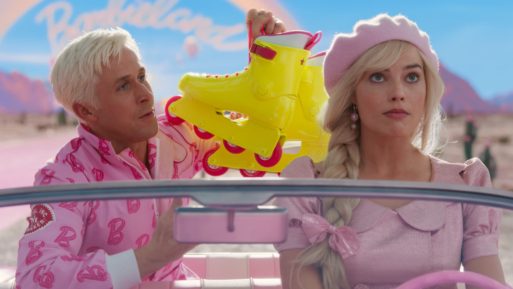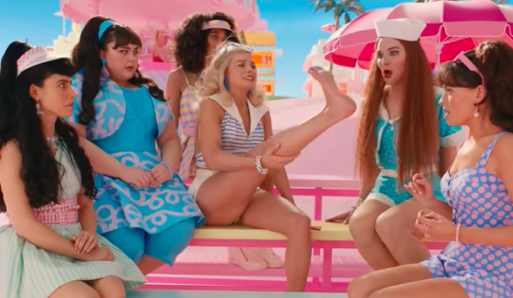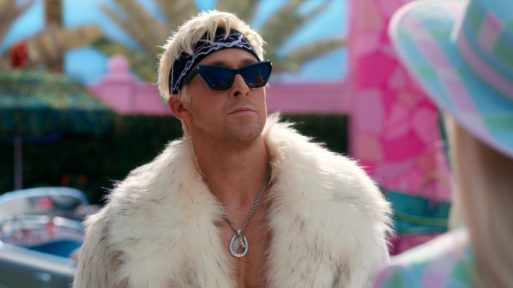
Barbie and Ken begin their journey from Barbieland into the real world.
Credit: Warner Bros. Pictures
Even if people haven’t yet seen “Barbie” — Director Greta Gerwig’s fuchsia-colored smash summer hit – they’re likely to have watched the trailer, in which Barbie, played by Margot Robbie, brings her house party to a record-scratching halt with the question: “Do you guys ever think about dying?”
Clearly, none of the other Barbies and Kens in Barbieland do. And Robbie’s character – identified as “Stereotypical Barbie,” or just “Barbie,” as opposed to other iterations including “President Barbie,” “Scientist Barbie” or “Weird Barbie”– hasn’t either, at least not until something goes terribly wrong. In a complicated tangle of alternate realities, someone playing too hard with Barbie in the real world causes her Barbieland counterpart’s feet to fall flat; thighs to gain cellulite; and thoughts to tend toward … well, death.

Barbie shows her flat feet to the other Barbies in Barbieland.
Credit: Warner Bros. Pictures
In an attempt to rectify this terrifying situation, Barbie ventures into reality to mend the rift between worlds, accompanied by Ken (Ryan Gosling). She’s shocked to find that in contrast to Barbieland, men in the real world hold the power – and wield it aggressively to subjugate women, exploit the planet, and execute their childish and poorly thought-out ideas. Ken, on the other hand, is thrilled by this discovery. He promptly returns to Barbieland, where he proceeds to assert the patriarchy by turning it into Kenworld, complete with mini-fridges, “long distance, low-commitment casual girlfriends” who serve up cold beer, and, somewhat confusingly, lots and lots of horses.

Ken embraces his new patriarchal self.
Credit: Warner Bros. Pictures
With its campy songs and costumes, and its scathing monologues about the demands placed on women, the film by Greta Gerwig is anything but subtle – except, perhaps, in its nods to other movies and to Barbie-maker Mattel. Nevertheless, a more profound and possibly unintentional question lies just beneath its shiny, plastic surface. Does humanity’s failure to accept the inevitability of aging and death contribute to the patriarchal violence and absurdity so evident in the real world? How might reorienting toward the transience of our existence change the way we treat each other and the Earth?
“Barbie” doesn’t answer these questions. But in the real world, Barbie does get the chance to experience her own humanity. She encounters an elderly woman (costume designer Ann Roth) at a bus stop – apparently, one of the first she’s seen – and finds her intriguing and beautiful. She experiences crying for the first time, which she discovers can actually be cathartic. She becomes catatonically depressed and claims that she is “not good enough.” As Gerwig told Rolling Stone:
“I started from this idea of Barbieland, this place with no death, no aging, no decay, no pain, no shame. We know the story. We’ve heard this story. This is an old story. It’s in a lot of religious literature. What happens to that person? They have to leave. And they have to confront all the things that were shielded from them in this place.”
Not surprisingly, Barbie returns to Barbieland to halt the spread of patriarchy and return the Barbies to their rightful position. Importantly, in this process, the Kens realize that patriarchy has given them no more identity or agency; it has simply locked them into a limited and unfulfilling role. As a result, they are forced to discover who they truly are, beyond becoming a tyrant or reducing themselves back to being Barbie’s sidekick.
The true meaning of power is demonstrated at the movie’s end, when Barbie chooses to become human – despite her understanding of the depth of feelings involved. “Humans have only one ending,” the ghost of Barbie’s creator, Ruth Handler, warns Barbie. “Ideas live forever.”
Nevertheless, Barbie chooses human life, and death – along with all of its flat feet, cellulite, tears of grief, and emotional disruption. In doing so, she confronts patriarchy in what may be the most profound manner possible. Not only does she accept the inevitability of death and loss, but in an age of heart-numbing substances, ambitions and distractions, she makes a revolutionary choice: The choice to feel.

 A Barbie Girl in a Deathless World Meets the Patriarchy
A Barbie Girl in a Deathless World Meets the Patriarchy


 How Dare You Die Now!
How Dare You Die Now!
 Debating Medical Aid in Dying
Debating Medical Aid in Dying
 “Help Me, Helen”
“Help Me, Helen”














